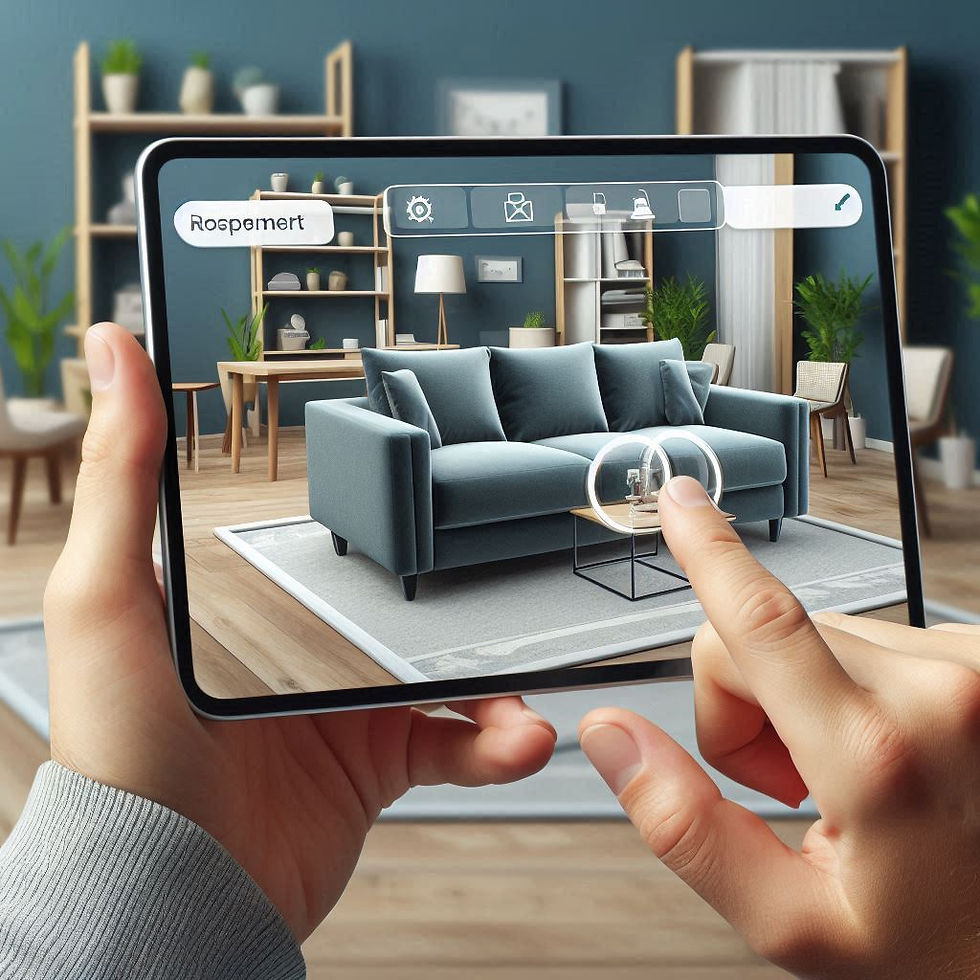How to overcome The Rising Challenge of Return Fraud in the Furniture Industry with WebAR
- Marvin XR

- Sep 10, 2024
- 6 min read

The furniture industry, like many others in the e-commerce space, faces a unique set of challenges when it comes to handling returns. Although furniture returns happen at a lower rate compared to other e-commerce products, the associated costs can be disproportionately high. Large items, bulky specialized packaging, and labor-intensive logistics all contribute to making each return a costly affair.
Even more concerning for online furniture retailers is the potential for fraudulent returns. While dishonest customers have always existed, the rise of e-commerce has opened the door to new tactics for exploiting return policies. These fraudulent returns are increasingly becoming a pressing concern for retailers.
A recent survey by the return management platform Loop shed light on the scale of the issue. It revealed that return fraud and policy abuse are now among the top challenges for retailers, with 44% and 43% of retailers, respectively, citing these as major concerns. In fact, 99% of the surveyed companies reported experiencing some form of return fraud or policy abuse within the last year.
Retailers attribute the surge in fraudulent returns partly to the current economic climate. Nearly 43% believe that financial pressures are pushing customers to exploit lenient return policies. Others point to dissatisfaction with product quality (41%) and customers who only intend to use items temporarily before returning them (35%).

The survey also identified some key trends in return fraud. Quality disputes were the most commonly cited form of fraud, experienced by 53% of respondents. This was followed by attempts to return ineligible items, which affected 44% of retailers.
Despite these challenges, only 46% of retailers felt that their detection and prevention measures were highly effective.
This gap is leading many companies to adopt stricter strategies to combat return fraud, including:
Stricter return policies (47%)
Banning repeat offenders (41%)
Introducing return fees (37%)

As the furniture industry continues to navigate the growing complexities of e-commerce, developing stronger fraud prevention measures is becoming more critical than ever. While honest customers remain the majority, the actions of a small minority can lead to significant financial losses for retailers. Proactive steps, such as refining return policies and improving fraud detection, are essential to minimizing the impact of this increasingly common issue.
There is another way to combat the above discussed problem which is Implementing WebAR in their existing website.

How WebAR Can Help Furniture Companies Reduce Product Returns
In the world of e-commerce, product returns represent a significant challenge for furniture companies. With large, bulky items that are expensive to ship and return, the costs add up quickly, eating into profits. In fact, furniture retailers face some of the highest return costs in online retail due to factors like logistics, packaging, and restocking labor. Fortunately, emerging technologies like WebAR (Web-based Augmented Reality) are providing innovative solutions that can help furniture companies minimize returns and improve customer satisfaction.
Understanding the Problem of Furniture Returns
Furniture returns are particularly problematic for several reasons:
High Shipping Costs: Transporting large furniture items back and forth is costly.
Packaging Issues: Damage often occurs during returns, rendering the item unsellable.
Complexity of Assembly/Disassembly: Customers may struggle to properly repackage or disassemble items for return.
Expectations vs. Reality: Shoppers might return products that don’t look or fit in their space as they had imagined when buying online.
These returns not only affect profitability but can also harm a brand’s reputation by leading to customer dissatisfaction. But WebAR offers a way to address these issues by providing customers with a more accurate representation of furniture before purchase.
How WebAR Reduces Product Returns
1. Accurate Visualization in Real-Time
One of the most significant advantages of WebAR is its ability to show customers exactly how a piece of furniture will look in their space. With WebAR, shoppers can use their smartphone or computer to project a 3D model of the furniture into their real-world environment. This allows them to visualize the size, color, and style of the item in relation to their existing décor.
For example, a customer can place a virtual sofa in their living room through WebAR, ensuring it fits both aesthetically and dimensionally. This drastically reduces the likelihood of returns caused by poor sizing or mismatches with home interiors. Customers gain confidence in their purchases, knowing the product will look just right in their home.

2. Enhanced Product Detail
Another feature of WebAR is the ability to zoom in on product details that may not be fully conveyed through traditional product images. Shoppers can inspect textures, finishes, and other intricate details as if they were physically handling the furniture in a store. By providing a more detailed view, WebAR helps eliminate surprises upon delivery, which is a major cause of returns.
For instance, a customer purchasing a wooden dining table can closely examine the grain, polish, and color variation, giving them a much clearer sense of the product’s quality and craftsmanship. This transparency helps set accurate expectations, thereby reducing returns due to dissatisfaction with product quality.

3. Custom Fit and Style Matching
Furniture is often returned because it doesn’t quite match a room’s style or fit within the existing layout. With WebAR, customers can try multiple furniture pieces and configurations before making a purchase, ensuring they make the right choice. By allowing them to see how the item looks in different lighting conditions or from various angles, WebAR helps eliminate style or design mismatches that typically lead to returns.
Moreover, WebAR can simulate the presence of other objects in the room, allowing customers to see how different pieces of furniture will complement each other. Whether it’s matching a coffee table with a sofa or ensuring a bookshelf fits into a tight corner, the virtual visualization offers far greater clarity than standard images or measurements.

4. Informed Buying Decisions
Shoppers often experience uncertainty when making large purchases, especially for expensive furniture items. This uncertainty can lead to second-guessing or buyer’s remorse, both of which drive returns. By using WebAR to simulate the furniture in the customer’s space, furniture companies can help shoppers make more informed and confident buying decisions.
With the ability to virtually "try before you buy," customers are more likely to feel assured about their purchase and less likely to return the item due to dissatisfaction. WebAR essentially acts as a decision-support tool that bridges the gap between online browsing and in-person evaluation.

5. Reducing "Just Trying It Out" Returns
Some returns occur because customers are simply testing out a product, with no real intention of keeping it. WebAR allows customers to experience a highly accurate preview of the furniture without the need to physically receive and assemble the item. By giving shoppers a realistic virtual experience, WebAR helps cut down on these types of “just trying it out” returns, as customers can get the information they need without committing to a purchase.

Implementing WebAR: A Smart Investment for Furniture Retailers
Given its ability to reduce product returns, WebAR represents a smart investment for furniture retailers. Not only does it improve the customer experience, but it also directly contributes to the bottom line by reducing the high costs associated with returns. Many companies have already begun integrating WebAR into their e-commerce platforms, seeing measurable results in reduced return rates and increased customer satisfaction.
Case Study: WebAR Success in Furniture Retail
BILLINGS is a Los Angeles based auction house known for hosting a large collection of modern design, furniture, art, decorative objects and accessories. On a quarterly basis, they host 300-400 collectible items during online & offline auctions.
During the Fall 2023, Billings decided to work with Marvin XR and adopt 3D product visualization and AR offering for selected items to empower the online bidders with more clarity regarding the product specifications before they place bids online. Which resulted in revenue up by 14.58%.
This case study focuses on the effect of AR during and after the auction (closure of the bids of items).
Conclusion
WebAR is transforming the furniture industry by addressing one of its most significant challenges: costly product returns. By providing customers with a more accurate and immersive way to visualize furniture in their homes, WebAR reduces mismatches in expectations, boosts customer confidence, and ultimately lowers return rates. As furniture retailers continue to adopt this technology, they will not only see improvements in their return metrics but also gain a competitive edge in the increasingly digital marketplace.
For furniture companies looking to thrive in the e-commerce space, WebAR offers a powerful tool to create a seamless and satisfying shopping experience—one that minimizes the pain points associated with returns and maximizes customer loyalty.
Marvin XR offers end to end 3D services for the online furniture brand founders who are ready to boost their business quickly. We take the ownership to provide the following:
Ultra high quality 3D modeling based on 4-6 images
Web based AR campaigns creations in bulk with no-code platform
3D Rendering (HDR photoshoot using 3D models)
3D Configurators for adding customizations to online user experience
3D Videos (HDR videos based on 3D models)
Marvin Integration Tool for easy 3D integration to any platform
Track KPIs, Online 3D editors, quick update of product catalogues and many.
Contact us today at support@marvinxr.com for a free consultancy to evaluate your 3D business vision for a better and successful future.




Comments